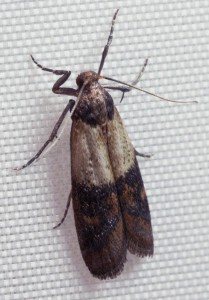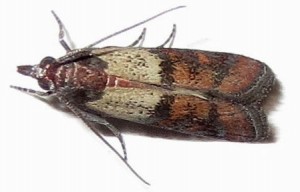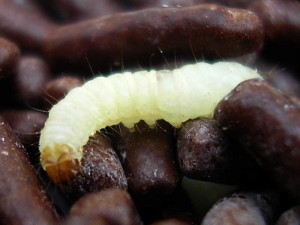Facts about Indian Meal Moths
Occurrence: The indian meal moth (Plodia interpunctella) originally comes from South America but can now be found almost worldwide, especially in warmer countries. In the UK, they are less common than clothes moths and case-bearing clothes moth but are as common as brown house moths.
Diet: It’s the larvae of the indian meal moth that are the actual pests. They can feed on a wide range of vegetable materials, but in households and storage facilities, they primarily target cereals, bread, grains, pasta, rice, raisins, flour, spices, nuts, dried fruits, and similar items. They are sometimes also found in chocolate, cocoa, instant coffee, etc.
Control: Effective control of indian meal moths largely involves removing their eggs, larvae, and growth opportunities. This is best done by cleaning their habitats—such as cupboards and shelves in the kitchen—and storing all dry food items in airtight containers. Read more about control below.
The indian meal moth thrive in dry foods and are best controlled by cleaning and proper storage of food
Controlling Indian Meal Moths
Here is a step-by-step guide to combat indian meal moths in the home—but remember that persistent or recurring issues with these moths may originate from your food supplier (supermarket, grocery store, etc.), and control should also be carried out there!
- Move all food out of the cupboards/shelves and inspect it for infestation.
- Discard all infested food and dispose of the trash in your outdoor garbage bin.
- Thoroughly clean all cupboards/shelves:
- Start by vacuuming them, paying particular attention to edges, corners, cracks, crevices, holes, etc.
- Wipe down the surfaces with a cloth dampened with plain vinegar mixed with a bit of organic peppermint or tea tree oil (vinegar and essential oil in combination are very effective against indian meal moths)—do not use water!
- Store all food in tightly sealed containers (not plastic bags).
- Place a few bay leaves in each cupboard/shelf (bay leaves have a repellent effect on indian meal moths).
- Set up Mediterranean flour moth traps.
Note that the method described above is a combination of good hygiene and home remedies, but it is both effective, eco-friendly, and safe for health as well as food.
Also, remember never to use water when cleaning during a moth infestation, as some species rely heavily on moisture and may thrive even better if you wet their habitats.
For severe or recurring infestations, it may be necessary to remove kitchen elements such as cupboards, appliances, range hoods, etc., to inspect the areas behind them for moth larvae and eggs. If found, these should, of course, be removed, and the areas cleaned with a vacuum cleaner and possibly a cloth as described above.
Preventing Future Infestations
Preventing future infestations is largely about hygiene:
- Store all food in airtight containers (not plastic bags).
- Clean cupboards and shelves regularly according to the instructions above.
- Periodically sort through food in your kitchen cupboards.
- Discard all food that has exceeded its expiration date.
- Place bay leaves next to food items.
- Purchase smaller quantities of dry food at a time.
- Set up mediterranean flour moth traps.
The first point above—regarding food storage—is very important because indian meal moth larvae can eat through plastic bags (including very thin plastic containers), paper, cardboard, and textiles. They can also crawl through twisted bag openings and up glass containers into loosely screwed lids.
When purchasing dry foods, you can opt to freeze them for about a week immediately after buying, which kills any potential eggs. However, not all dried foods can tolerate freezing.
It’s also important to remember that moth eggs and larvae can sometimes come directly from your local food store (or an earlier stage in production or distribution). In such cases, you should alert the store to the problem.
Insecticides
There are various moth control products for combating brown house moths, including moth traps, capsules, and hangers. The commonality among these products is that they emit pheromones that attract moths.
However, most moth control products are not very effective because they only attract and kill adult male moths; in other words, they do not remove the root cause of the problem (i.e., the eggs and larvae as well as the female moths), but only the superficial symptom of the problem.
Additionally, many moth control products are not suitable for use around food—where indian meal moths tend to live. Moth traps, however, can be practical for monitoring the extent and development of an infestation. They typically last for 4–6 weeks.
There are also insecticides that are suitable for killing insects more broadly. We do not recommend using such insecticides in any form of moth infestation—read more about this in our article on moth sprays.
Signs of a Moth Infestation
In the UK, when moth-infested food is discovered, it is usually due to indian meal moths. The infestation typically occurs in dry foods such as cereals, bread, grains, beans, lentils, bulgur, pasta, rice, raisins, flour, spices, nuts, dried fruits, semolina, and similar items, but it can also happen in chocolate, cocoa, instant coffee, and more.
Revealing signs of an infestation include:
- Food: Food attacked by larvae may contain webs (similar to spider webs), be clumped together, or be soiled by the larvae’s droppings.
- Larvae: Newly hatched larvae are very small and difficult to spot, but when fully grown, they are visible (if you can find them!). In some cases, adult larvae can be seen in or around food. In the latter case, they often try to hide in dark corners, cracks, or crevices. They are yellowish or whitish with dark brown heads. When fully developed, they measure 12–13 mm. Read more about moth larvae here. Read more about moth larvae here.
- Adult moths: If adult moths are flying or crawling around, this is, of course, an obvious sign of their presence. By observing a moth, you can quickly determine if it is an indian meal moth or another species (indian meal moths are 0.8–1 cm long with a wingspan of 1.6–2 cm. The upper third of their wings is light gray, while the lower half is reddish-brown). All adult moths should be killed immediately.
In larger commercial storage facilities (such as grain warehouses), indian meal moths can cause significant problems by destroying large amounts of food in a short time.
The larvae of the indian meal moth have a white body and dark brown head. When newly hatched, they are difficult to spot, but later they can be seen.
Discarding Food
Whether to discard infested food depends on the extent of the infestation:
- If the damage to the food is very minimal, you can heat the food to 60°C (e.g., in the oven) for 1 hour or freeze it for 2 days in a freezer at -18°C or lower temperatures.
- If the food has visible significant damage, it should be discarded—be sure to take out the trash as quickly as possible.
Description of Indian Meal Moths
An adult indian meal moth is 0.8 – 1 cm long with a wingspan of 1.6 – 2 cm.
The upper third of their wings is light gray, while the lower part is copper-red. This distinct color division of the wings gives the moth its name and makes it easy to distinguish indian meal moths from other moth species.
Adult moths are most active at night and are attracted to light.

Life Cycle
For indian meal moths, the development of larvae depends significantly on temperature; in cold environments, it is very slow or even halted, while in optimal conditions (around 30°C), it only takes about 25 days.
In one year, there can be 7 – 9 generations, but in many cases, there are only 1 – 2 generations due to temperature conditions.
The life cycle, under optimal conditions, spans about 28 days, unfolding as follows:
- The adult female indian meal moth lays her eggs (typically 100 – 300) on or inside dry food items (they can also be laid in a crack or crevice in the food’s packaging). The eggs are laid individually or in groups of 12 to 30.
- The eggs begin to hatch after 2 – 14 days, depending on the environment.
- The newly hatched larvae feed on the food in which they hatch and can penetrate almost all types of dry food due to their extremely small size. However, they cannot chew through packaging but must instead find a small opening or hole, which usually is not difficult.
- The larval stage lasts between 2 weeks and 1 year, and it is during this stage that food is damaged. When fully grown, the larva spins a light brown cocoon where it pupates.
- After 4 – 30 days, the moth emerges from its cocoon as an adult indian meal moth and mates with the opposite sex. The female moths then lay eggs, starting the next generation.
- Adult indian meal moths live for 5 – 25 days.
A female moth can lay up to 400 eggs in her lifetime. You can read more about the moth life cycle here.


